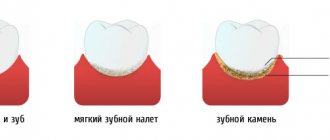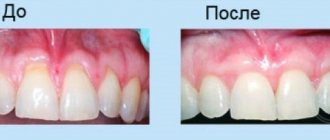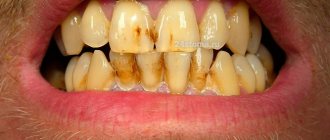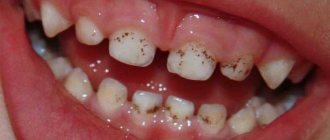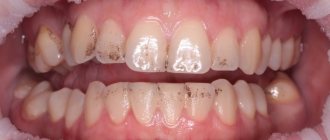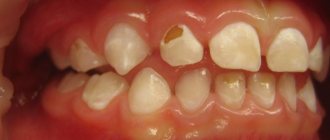Surface formations on teeth
On the surface of the tooth there is a cuticle, pellicle, as well as plaque and tartar (with poor oral hygiene).
The cuticle, or reduced epithelium of the enamel organ, is lost soon after eruption, and therefore does not play a significant role in the physiology of the tooth. This formation, found mainly in the subsurface layer of enamel, sometimes comes to the surface in the form of a microscopic film.
In some places, the cuticle in the form of a tube reaches the enamel-dentin junction.
Pellicle (acquired cuticle) is formed from salivary glycoproteins on the surface of the tooth after its eruption. If the tooth comes into contact with saliva, then when the pellicle is removed with an abrasive, it is quickly restored. The pellicle is a structureless formation, tightly fixed on the surface of the tooth, and plays an important role in the selective attachment of bacteria.
The processes of diffusion and permeability in the surface layer of enamel depend on the state of the pellicle. To a certain extent, this shell protects the integrity of the enamel structure, but a large number of pellicles is not an indicator of enamel resistance.
Above the pellicle you can find dental plaque - a dense formation consisting of bacteria located inside a matrix, which is formed by proteins, polysaccharides, lipids and some inorganic substances (calcium, phosphates, magnesium, potassium, sodium, etc.)
Plaque is attached to the tooth surface less tightly than pellicle, and at the same time, unlike food debris, it cannot be removed by simple rinsing. Plaque begins to accumulate soon after brushing your teeth; it is formed by the adsorption of microorganisms on the surface of the enamel and grows due to the constant layering of new bacteria, and in a certain sequence: first, coccal flora, and then rod-shaped and filamentous bacteria. As plaque grows and its thickness increases, anaerobic forms of bacteria begin to predominate.
Plaque has a porous structure, which allows carbohydrates to freely penetrate into its deep layers. When eating soft foods and consuming a significant amount of easily fermentable carbohydrates, its significant and rapid growth occurs.
Most often, dental plaque is located above the gum, in the cervical region, in fissures, and more microorganisms accumulate at the entrance to the fissures than in the depths.
80-85% of dental plaque consists of water. As for mineral components, calcium, general and inorganic phosphates, and fluorides predominate. Calcium in plaque may be associated with bacteria, extracellular proteins, or phosphates, which in turn may exist as inorganic orthophosphate or organic compounds. Fluoride is present in low concentrations in plaque fluid and in high concentrations in solid plaque. Although the mechanism of fluoride binding in plaque has not been fully elucidated, there are suggestions that the ion accumulates inside bacteria and forms extracellular complexes with calcium. The aqueous phase (plaque fluid), constituting 25-35% of the total volume, is located extracellularly and is an “incubation medium” for bacteria.
Plaque can be white, green or brown.
Soft white plaque, visible without staining with special solutions, accumulates mainly during the period of rest of the speech and chewing apparatus and in the absence of proper oral hygiene. This type of plaque can cause bad breath, distort the sense of taste, and also serve as a center of mineralization during the formation of tartar.
Green plaque, more often observed in children and young patients, is located in a thin layer on the labial surfaces, mainly of the front teeth. The appearance of this plaque is associated with the vital activity of chromogenic microorganisms containing chlorophyll.
Brown plaque is more common in smokers, and its color depends on the nicotine and intensity of smoking. It is difficult to clean with toothbrushes and toothpastes, but dental plaque can be white, green and brown. To remove it, teeth should be treated with hard brushes and special fine pastes.
Brown plaque can also occur in non-smokers due to a large number of copper amalgam fillings, as well as in people who work on the manufacture of copper, brass and bronze products. In children, plaque of this color often forms on baby teeth when a large amount of unreduced iron is secreted with saliva, which, combining in the oral cavity with sulfur from decaying protein substances, causes staining.
Calcification of dental plaque leads to the formation of tartar, hard deposits of varying consistency and color. Calcium phosphate crystals that are deposited within plaque may be closely associated with the enamel surface. Sometimes, especially in the presence of demineralization, it is difficult to determine where the enamel ends and the stone begins. For the formation of supragingival calculus, minerals coming from saliva are used mainly, while subgingival calculus is used from gingival fluid. The organic part of the stone is a protein-polysaccharide complex, including epithelial cells, leukocytes, microorganisms, and food debris.
Stone deposition, sometimes of considerable thickness, occurs in both the subgingival and supragingival areas. Calcification begins in plaque, which is present on the teeth for at least a few days.
Supragingival tartar is most often localized in the area of the lower frontal teeth and the buccal surfaces of the upper molars, where the ducts of the salivary glands open. In the absence of hygienic care, stone formation occurs on teeth that are not involved in the act of chewing. The color of the stone (white, yellow, brown) depends on the effects of food, nicotine, as well as oxides of iron, copper and other substances.
Subgingival tartar is revealed only by probing. It is usually dark brown in color with a greenish tint, and is formed on the neck of the tooth within the gingival groove, on the root cement, in the periodontal pocket. The stone surrounds the neck of the tooth, often forming projections, and is firmly attached to the underlying surface.
If a patient develops a significant amount of tartar, this may be due to a decrease in the concentration of pyrophosphate, a tartar inhibitor, or the absence of a specific salivary protein that prevents calcium phosphate precipitation and crystal growth.
Pellicle of the tooth
State budgetary educational institution
Higher professional education
Novosibirsk State Medical University
GBOU VPO NSMU
Department of Medical Chemistry
UIRS
On the topic: “ Tooth pellicle: features of composition and properties
»
Performed:
Natalchenko Damilya
II year, 14 group
Checked:
Poteryeva O.N.
Novosibirsk
2014
Tooth pellicle (lat. pellicula, diminutive of peilis - skin, skin) is an acquired, genetically non-determined film that appears on the surface of human teeth after they erupt. A characteristic feature of a pellicle is a jagged edge and niches in which microorganisms develop. The thickness of the daily pellicle is 2–4 µm. The pellicle contains a lot of glutamic acid, alanine, sialic acid, and amino sugars. Protects hard tooth tissues from acids, but promotes the fixation of microorganisms. The pellicle is a structural element of the surface layer of enamel and can only be removed with strong abrasives. A toothbrush is not effective.
It is represented mainly by white education
, with a small amount of protein-bound carbohydrate components (hexose, fucose, etc.).
Consists of 2 protein fractions. Includes glycine, glycoproteins, individual amino acids, amino sugars, which are formed as a result of the activity of bacteria. There are 3 layers in the structure: the first - subsurface -
is located in the thickness of the enamel and has many processes that fill the pores, cracks and weakly mineralized areas of the enamel;
the second layer - the middle one
- is closely related to the tooth enamel and has a uniform thickness;
the third is the surface layer of enamel
, it is located in hard-to-reach places, or under a dental
plaque
.
The pellicle is difficult to detect with the naked eye, it tends to attach bacteria to the surface of the tooth, which leads to the formation of aggressive plaque, which is called plaque. To detect pellicles in clinical settings, dyes are usually used, for example, erythrosine, under the influence of which it acquires a bright red color, or Lugol's solution or 2% methylene blue. A colored pellicle can often be found in the clinic under the influence of chromogenic bacteria, smoking, the use of a number of medications, etc.
The formation of a pellicle begins with the interaction of acidic groups of glycoproteins and Ca2+ of tooth enamel, while the main groups of glycoproteins react with hydroxyapatite phosphates. The layered structure of the pellicle determines the difference in charges in the interior and on the surface, which gives the pellicle the properties of a semi-permeable membrane. The pellicle differentiates the flow of macro- and microelements from and into the enamel, ensuring its trophism, ripening and remineralization.
The following are involved in the formation of tooth pellicles:
- Acidic proteins rich in proline;
- Glycosylated proteins rich in proline;
- Mucins;
- Lactofferin;
- Hisstatins;
- Low and high molecular weight carbohydrates.
Ionic bonds and hydrophobic interactions occur between the enamel surface and the deposited proteins..
Attachment of proteins to enamel occurs due to the formation of calcium bridges (Fig. 1).
Fig.1
In the oral cavity, when a tooth comes into contact with saliva, it can form within 20-30 minutes.
The pellicle is of great importance in the processes of diffusion and permeability in the surface layer of enamel, in protecting teeth from the effects of dissolving agents. It gives the enamel selective permeability. However, under unfavorable situations in the oral cavity, the pellicle can swell, change its composition and properties, and in this state favor the development of dental caries. Particularly interesting for the purpose of preventing dental caries is the selective permeability of the pellicle to a number of substances. This biological membrane can regulate the diffusion of various solutions from saliva into the tooth and from the tooth into saliva.
The condition of the pellicle can serve as a factor that either accelerates the occurrence of caries, or, conversely, enhances the remineralization of enamel.
Recently, the clinical role of the pellicle under the influence of various anti-caries agents, in particular fluoride preparations, has been intensively studied. It was found that the pellicle delays the return of fluoride from the enamel. In addition, it helps regulate the flow of fluoride into the enamel with the aim of forming more durable compounds - fluorapatites.
Acquired dental pellicle (APD) proteins are endowed with protective properties
:
- Using various mechanisms, PPP proteins destroy microorganisms or prevent their adhesion.
- For example: secretory (from saliva) immunoglobulin A (IgAs) prevents bacteria from sticking to the surface of tooth enamel.
Bibliography:
- Source: https://krasgmu.net/publ/1/5-1-0-73
Dental plaque
- Source: https://medbookaide.ru/books/fold1002/book1007/p5.php
Biochemistry of the oral cavity
- L.M. Tarasenko, K.S. Neporada - Textbook for students - Biochemistry of the oral cavity, 2008. Publishing House "Poltava"
Features of ciliate pellicles
Ciliates have a very diverse shape. They can be:
- oval;
- oblong.
The sizes of ciliates vary from thirty to forty micrometers. These are the most complex protozoa, which have very original integuments. Their cytoplasm always has two layers:
- external – ectoplasm or elastic pellicle;
- internal – endoplasm.
The outside of the pellicle often has a sculptured structure with regularly spaced thickenings. The thickenings of the ciliate slipper in the pellicle area have the shape of regular hexagons, reminiscent of a honeycomb. For a pellicle, such a structure is very justified, since it significantly increases the strength of this formation.
Are you an expert in this subject area? We invite you to become the author of the Directory Working Conditions
Externally, the body of the ciliate is covered with cilia, which begin from the pellicle and its basal bodies. The number of cilia is very large and can be up to 10 thousand. According to the internal structure, cilia consist of two fibrils and nine fibrils reaching the periphery.
They continue in the kinetosome and acquire a triple structure. If the cilia are not arranged in rows, but evenly, then this is a primitive sign of ciliates. The locomotor apparatus of ciliates specializes in two directions:
- cilia concentrate on certain areas of the body;
- the cilia stick together and retain their own individuality as part of large working complexes.
When the cilia are connected in one or more rows, a ciliated membrane is formed, which is located on the pellicle. All these structures are called membranellas. If the cilia located on the pellicle in the form of a brush connect, a cirri is formed.
The most complex apparatus of cilia is found in ciliates in the area of the mouth. There are ciliates that have contractile fibers or myonemes; they are capable of sharp contraction. This significantly increases the possibility of movement of ciliates, despite the density of the pellicle.
Finished works on a similar topic
Coursework Pellicle of ciliates 480 ₽ Abstract Pellicle of ciliates 240 ₽ Examination Pellicle of ciliates 220 ₽
Receive completed work or specialist advice on your educational project Find out the cost
The pellicle of ciliates contains specialized formations called trichocysts.
Definition 2
Trichocysts are small protective spindle-shaped formations that are located in the cytoplasm of the ciliate perpendicular to the surface of its body. When exposed to any external irritants, they are thrown out and take the form of long threads with sharp points at the ends.
In addition, in the pellicle of ciliates there are peculiar structures in the form of plaques and hexagons, similar to trichocysts. Their threads are also capable of twisting and unwinding. In some ciliates, the pellicle may have a glassy structure, and it may be arranged in folds.
Other ciliates have a delicate, armor-like pellicle. The pinnate is in the form of a narrow strip from the anterior pole to the middle of the body. The edge of the peristome (the primary part of the cell mouth) is surrounded by two membranes.
